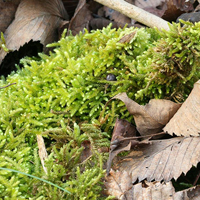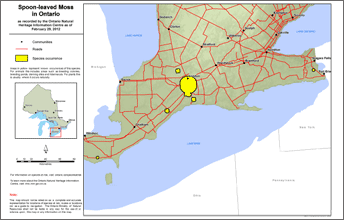Spoon-leaved moss
Scientific name: Bryoandersonia illecebra

Photo credit: Allen Woodliffe
Status
Threatened
Threatened
means the species lives in the wild in Ontario, is not endangered, but is likely to become endangered if steps are not taken to address factors threatening it.
Date added to the Species at Risk in Ontario list
Spoon-leaved moss was already assessed as at-risk when the Endangered Species Act took effect in 2008.
Read the most recent assessment report (PDF)
What it looks like
Spoon-leaved moss is a shiny, green to greenish yellow-brown species of moss with creeping stems and ascending, intertwined branches that form deep mats.
It is quite large and striking compared to most moss species. Its most distinctive feature is the smoothly cylindrical appearance of its stems and branches, especially when they are dry.
The leaves, which are up to 2.8 millimetres long, are closely overlapping, broad, deeply-concave, and cupped, like the bowl of a spoon.
Where it lives
Spoon-leaved moss grows in a range of habitat types but most Canadian populations are located on soil in low-lying areas that are seasonally flooded under trees or shrub thickets.
It is often found in close proximity to a species of moss called narrow-leaved wetland plume moss, which is associated with swamps, marshes, and wet meadows.
Where it’s been found in Ontario
Spoon-leaved moss is found only in eastern North America, from southern Ontario south to Texas and Florida. In Canada, it is restricted to a few sites in southern Ontario – Elgin, Essex and Welland counties, and the Niagara Region.
View a larger version of this map (PDF)
What threatens it
Habitat loss and degradation, usually due to expanding development, is the primary threat to Spoon-leaved moss in Ontario. Populations are threatened by off-road vehicles, trails establishment, garbage dumping and salt runoff from roads.
Invasive plants such as Glossy and European buckthorn, Autumn olive and Multiflora rose, pose a threat at some sites.
Action we are taking
Threatened species and their habitat are protected under Ontario’s Endangered Species Act, 2007.
Recovery strategy
A recovery strategy advises the ministry on ways to ensure healthy numbers of the species return to Ontario.
Read the executive summary and the full document (September 6, 2022).
Government response statement
A government response statement outlines the actions the government intends to take or support to help recover the species.
Read the government response statement (June 6, 2023)
Habitat protection
General Habitat Protection – June 30, 2008
What you can do
Report a sighting
- Report a sighting of an endangered animal or plant to the Natural Heritage Information Centre. Photographs with specific locations or mapping coordinates are always helpful.
Volunteer
Volunteer with your local nature club or provincial park to participate in surveys or stewardship work focused on species at risk.
Be a good steward
- Private land owners have a very important role to play in species recovery; if you find Spoon-leaved moss on your land, you may be eligible for stewardship programs that support the protection and recovery of species at risk and their habitats.
- Invasive species seriously threaten many of Ontario’s species at risk; to learn what you can do to help reduce the threat of invasive species, visit:
Report illegal activity
Report any illegal activity related to plants and wildlife to
Quick facts
- A previously unknown population of Spoon-leaved moss was discovered in Welland County in 2002.
- All populations of Spoon-leaved moss in Ontario, for which the sex has been determined, are female.
- Sporophytes – the part of the plant that produces spores – have not been observed in Ontario spoon-leaved moss.
- The genus of Spoon-leaved moss is one of only six genera of mosses that are endemic to eastern North America; Spoon-leaved moss is the only species in its genus.
